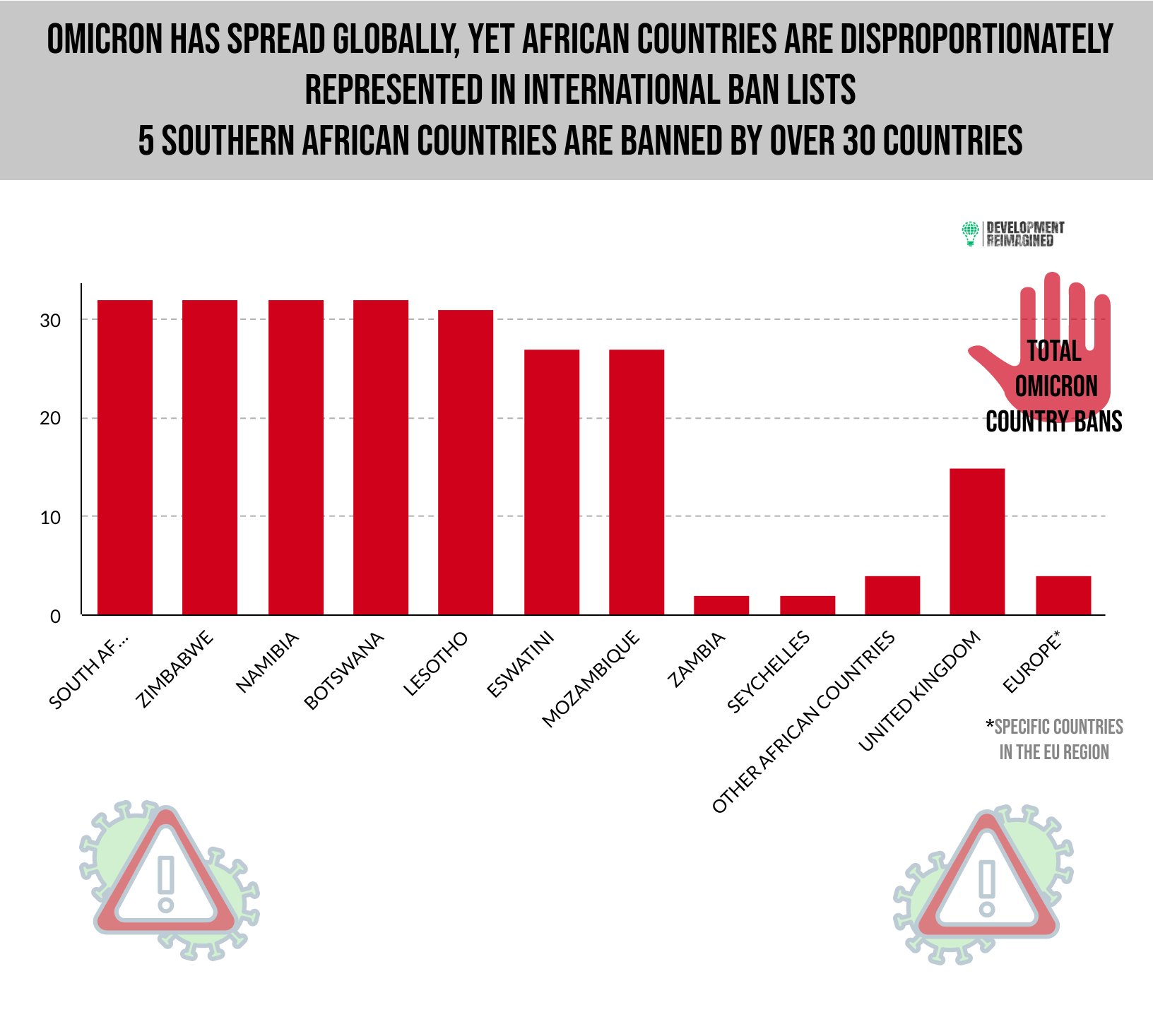Updated Every Month
During November 2021, the WHO announced a new COVID-19 variant of concern – B.1.1.529 – now known commonly as Omicron. First detected by South Africa and sequenced by Sikhulile Moyo, a researcher based in Botswana, over 11,000 global cases of Omicron have been recorded. Our final infographic of 2021 thus turns to the impact Omicron cases are having on African countries, and how this differs – if at all – from previous variants.
Month after month, our infographics have impartially analysed the data – and found that the vast majority of African countries consistently acting in a globally responsible manner. Hence, the data already shows that despite being first detected on the continent, the majority of Omicron cases are outside of African countries. EU countries account for 43% of worldwide Omicron cases and the UK alone accounts for 39%. Meanwhile, the entire African continent accounts for under 10% of identified Omicron cases. Moreover, Omicron case numbers also make up only a small proportion of overall active COVID-19 cases in African countries – 0.19%.
And yet, the global travel restrictions that have followed the emergence of Omicron have disproportionately targeted African countries. Less than 20 countries have implemented a travel ban on people travelling from the UK. Meanwhile, over 30 countries have implemented travel bans for people travelling from 5 southern African countries.
Not only do these restrictions disproportionately impact the economies of African countries and the lives of their populations, they have been widely labelled as ineffective and harmful in the long run. As Sikhulile Moyo highlights, tackling COVID-19 requires access to lab supplies and the exchange of knowledge through collaborative research. However, applying travel bans jeopardises these activities and thereby jeopardises successful management of COVID-19.
They are also wholly unnecessary. As we have tracked, since the beginning of the COVID-19 pandemic African countries have never really “opened up”. African governments have continuously used social distancing measures to contain the spread of COVID-19. Alongside vaccine deployment, this strategy continues – and includes a continent-wide commitment to mask mandates (especially in cities and indoors) and 93% of the continent implementing restrictions on public gatherings.
Furthermore, African countries remain committed to distributing the vaccines that they receive. Over half of all vaccines supplied so far have been administered. But supplies remain low and less than 3% of the global total. In other words, only 3 African countries have even had sufficient supplies to be able to vaccinate over 40% of their populations, but these are not the continent’s most populous nations. Most African countries cannot even think about plans to distribute booster vaccinations – believed to be important to avoiding Omicron or other new variants overwhelming health systems. Such plans have only been announced in 8 African countries so far – Tunisia, Mauritius, Seychelles, Rwanda, Zimbabwe, Mozambique, Eswatini and South Africa, and will of course be focused on priority populations within the countries.
As with all COVID-19 variants, Omicron highlights once more the importance of a collaborative global approach to tackling COVID-19, but also huge deficits when it comes to Africa. While the data shows that African countries have been and continue to be responsible global partners when it comes to COVID-19, the global collaboration to buttress this and support economic recovery still appears to be missing.
To review the data yourself, check out the graphics and numbers below, and do let us know what you conclude, and what you’d like us to find out next time.
 To find out how Development Reimagined can support you, your organisation or Government during the COVID-19 outbreak please email the team at clients@developmentreimagined.com .
To find out how Development Reimagined can support you, your organisation or Government during the COVID-19 outbreak please email the team at clients@developmentreimagined.com .
Special thanks go to Rosie Flowers-Wanjie, Osaru Omosigho, David Tinashe Nyagweta and Jing Cai for their work on the graphics and collecting/analysing the underlying data and this accompanying article.
The data was collated primarily from Africa CDC, as well as other sources including: government websites and media reports, the IMF policy tracker; Worldometer and the New York Times Vaccine Tracker. Our methodology is entirely in-house, based on analysis of vaccine, testing, spending, social distancing, income categories and other trends.
If you spot any gaps or have any enquiries, please send your feedback to us at team@developmentreimagined.com, we will aim to respond asap.
December 2021


